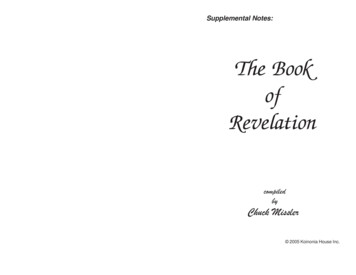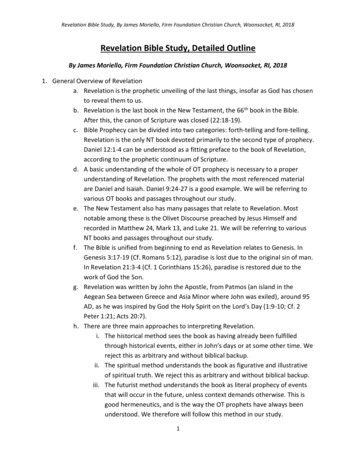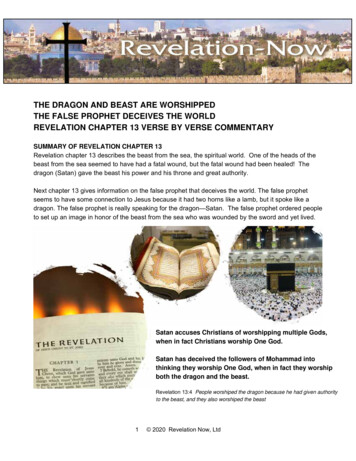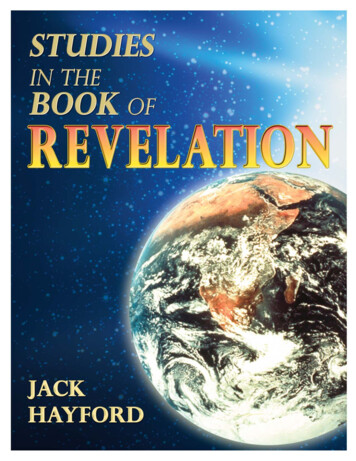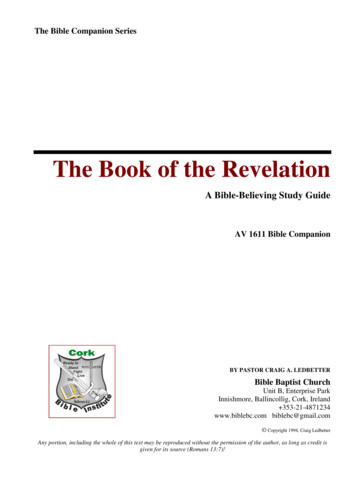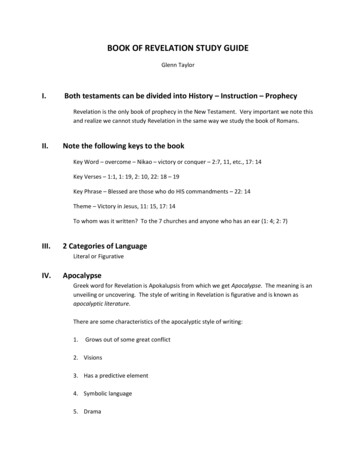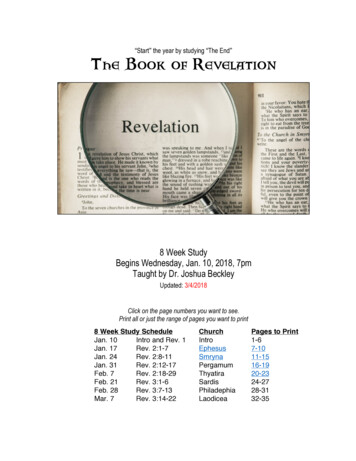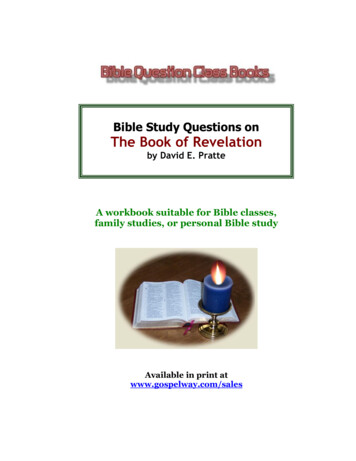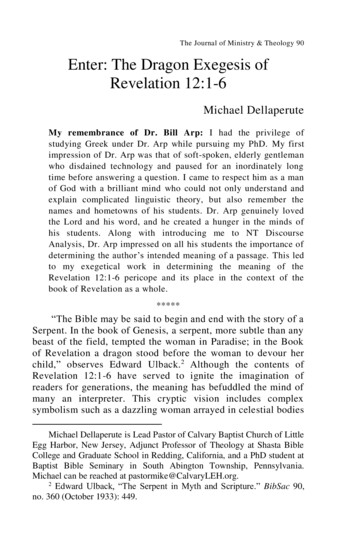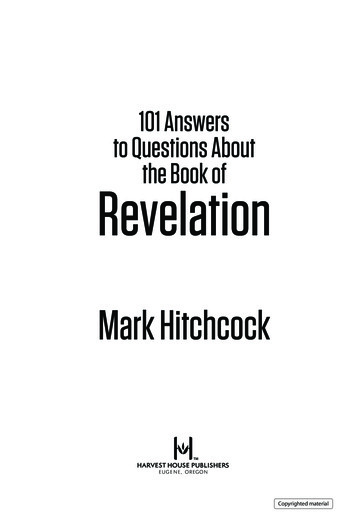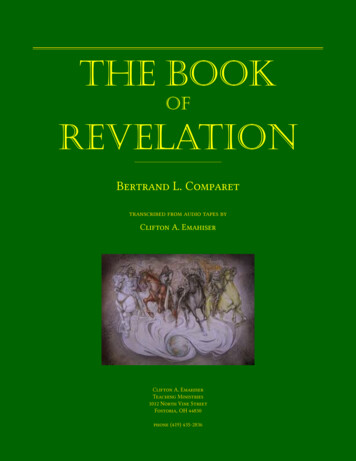
Transcription
The BookofRevelationB L. C C A. E C A. E T M 1012 N V S F , OH 44830 (419) 435 2836
C ONTENTS1 L ESSON 152 L ESSON 2253 L ESSON 3394 L ESSON 4495 L ESSON 5656 L ESSON 6797 L ESSON 7958 L ESSON 81099 L ESSON 912310 L ESSON 1014711 L ESSON 1116312 L ESSON 1217913 L ESSON 1319314 L ESSON 14213
Comments by William Finck initialed W.R.F.Comments by Clifton A. Emahiser in brackets in lesson text or initialed C.A.E.Unless in brackets, all of the message is by Bertrand L. Comparet.
L ESSON1I will tailor my subject for today to fit the particular day we have. I am going to drop you rightinto something deep from the start; that’s the Book of Revelation. I decided I’d better speak onit, if I am going to because, while some of it is prophesy of the future, it is developing into anaccomplished fact very rapidly these days. So I want to be able to say, a little later when, aftersome of these things have happened: “You see, I told you so.” We all like to brag a little. It’s adifferent book than any other in the Bible, although it’s closest to the Book of Daniel. Danielreceived, you know, a number of prophetic visions, and they were largely symbolic. In fact,you can say they were all symbolic. On the greater part of them, the meaning of this symbolicmessage was explained to him at the time. There were a few that were left to be explainedby the circumstances as they came about, and those tie in with the Book of Revelation. Sohere was Daniel in the period from, oh, say 605 B.C. to 535 B.C., in Babylon receiving theserevelations, and of course he didn’t know what John was going to receive in visions around 94to 96 A.D. But, we’ll see as we get into them how these prophesies tie into each other. Firstof all, in this Book of Revelation, the Revelation that was given to John by Yahshua the Christ[the Anointed]. And lest there be somebody who has been at some time misled by the common“church” doctrine of the trinity, that we have three separate and different Gods (just like thepagans, you know; they have a few more than we). But no, don’t be misled by that. Someof the preachers take that view, yet the Bible makes it clear that Yahshua the Christ, son ofYahweh, is at the same time Yahweh, Elohim, the Father Himself, and this is one of the placeswhere He tells us so in unmistakable words.11This note has reference to Comparet discussing the approximate date that John wrote his revelation in theopening paragraph of this lesson. The following documentation gives evidence to that date:Ante-Nicene Fathers, volume 5, ch. XLIX, par. 3: “John, again, in Asia, was banished by Domitian the king tothe isle of Patmos, in which also he wrote his Gospel and saw the apocalyptic vision; and in Trajan’s time he fellasleep at Ephesus, where his remains were sought for, but could not be found.”Ante-Nicene Fathers, volume 7, ch. X, par. 11: “He says this, because when John said these things he wason the island of Patmos, condemned to the labour of the mines by Caesar Domitian. There, therefore, he sawthe Apocalypse; and when grown old, he thought that he should at length receive his quittance by suffering,Domitian being killed, all his judgments were discharged. And John being dismissed from the mines, thussubsequently delivered the same Apocalypse which he had received from God. This, therefore, is what He says:Thou must again prophesy to all nations, because thou seest the crowds of Antichrist rise up; and against themother crowds shall stand, and they shall fall by the sword on the one side and on the other.”Conclusion: Domitian’s reign was 81 to 96 A.D., and if John was released from prison after Domitian’s death,that gives us evidence concerning the time period when John had his vision. Once one understands the datingof John’s vision somewhere between 81 to 96 A.D., how can anyone agree with the Praeterists’ theory that allprophecy was fulfilled by 70 A.D.? C.A.E. back to note 11 on page 45
6L ESSON 1 – T HE B OOK OF R EVELATIONC OMPARETJohn begins on the revelation of this thing: “I was in the Spirit on Yahweh’s day, and heardbehind me a great voice, as of a trumpet, saying, I am Alpha and Omega, the first and the last.” So he said he turned to look and see who was speaking to him, “I saw seven golden lampstands.” Your King James version says candlesticks, and the word used in the Greek does notmean candlestick at all, but a stand on which a lamp was placed, and we will see the reasonfor it. The lamp in ancient times looked very much like a modern teapot, except they werevery shallow. You put oil in the center pot of the thing, and there was a lid that fitted over it,and there was a cloth wick in the spout which absorbed the oil, and you set fire to the wick,and that burned the oil that gave the light. Thus, these were stands on which a lamp could beset; a pedestal. “I saw seven golden lamp stands, and in the midst of the seven lamp stands,one like to the son of man.” Now you will notice that is the title Yahshua the Christ used ofHimself many, many times in His ministry. And John says, “And when I saw him, I fell at hisfeet as dead. And he laid his right hand upon me, saying unto me, Fear not; I am the first andthe last: I am he that liveth, and was dead; and, behold, I am alive for evermore, Amen; andhave the keys of hell and of death.”You know, that is the most triumphant statement ever made, the complete conquest of all eviland its consequences. And, that is something for all of us to observe with joy. Who was it thatwas the first and the last? Well, as always, we turn for confirmation to the Old Testament.Isaiah 44, verse 6: “Thus saith Yahweh the King of Israel, and his redeemer Yahweh of hosts; Iam the first, and I am the last; and beside me there is no Elohim.” So, when Yahshua the Christis also able to say “I am the first and the last”, you know who He is! Again in Revelation 1,verse 8, He says, “I am Alpha and Omega, the beginning and the ending, saith Yahweh, whichis, and which was, and which is to come, the Almighty.” Couldn’t make it plainer! – could you?We’re going to touch later on this thing – really not today – I give you fair warning, I’m going totalk to you about this for more than one day. It’s a big subject, and we can’t skip over it lightly.As we get into latter portions of it, we’re going to show where some of them dovetail perfectlyinto Daniel’s prophesy. A number of things were left unexplained in Daniel, as we read inDaniel 12, verses 4, 8 and 9, the angel said to him: “But thou, O Daniel, shut up the words,and seal the book, even to the time of the end: . 8 And I heard, but I understood not: thensaid I, O my master, what shall be the end of these things? 9 And he said, Go thy way, Daniel:for the words are closed up and sealed till the time of the end.” They weren’t to be understoodin his day, but the fact that we can understand them now tells you something about where weare in Yahweh’s calendar. We’ve reached the time of the end. Now on the contrary, John wastold not to seal up the Book of Revelation. I don’t know how many different “churches” you’vegone to, but in most of them you’ve probably heard the preacher say he couldn’t understandthe Book of Revelation; it was a sealed book to him. Not because John or the angel sealed it,although it is the most difficult book in the Bible, being all in symbols. Revelation 22, verse10: “And he saith unto me, Seal not the sayings of the prophecy of this book: for the time is athand.”When John wrote this book – scholars have estimated the time to be 94 A.D. – some haveplaced it as late as 96 A.D., but it is within that period. Hence, what John was told was,
C OMPARETT HE B OOK OF R EVELATION – L ESSON 17in effect, in his day, and would continue on thereafter clear up to the return of Yahshua theChrist, and indeed, a little beyond. Now the first revelation that Yahshua the Christ gave tohim was in the form of a message to seven different “churches” [more properly Ekklesiae, or“Assemblies”]. At that time there were a large number of cities in Western Asia, and – oh, asfar away as Rome, which had flourishing Christian “churches.” And yet, out of all these, sevenwere singled out by name: Ephesus – Paul wrote an epistle to the Ephesians, you remember –Smyrna, Pergamos, Thyatira, Sardis, Philadelphia and Laodicea.Now no mention was made of Rome. Despite the Catholic “Church’s” claim that they are theoriginal “church”, they are not mentioned by name. And since the Catholic “Church” claimsthat its founder was Peter – note that this vision was not given to Peter, it was given to John. Nomention was made here of the “churches” at Corinth, Galatia, Philippi, Colossae, Thessalonica,to all of whom the apostle Paul wrote epistles which we still have in our Bible. No mention ofthe “churches” which were in Jerusalem, Miletus or Troas, which are all mentioned in the Bookof Acts. But seven have been singled out for special treatment here, and therefore there mustbe a reason for the selection of these seven. The literal language of the book talks of “churches”situated in seven different cities of Western Asia, and yet we have no record, either in historyor in the writings of the early “Church” fathers, to indicate that the conditions which it speaksof here were particularly noticeable in the “churches” of those particular cities, because you’llfind no two of them the same here. Thus, it is evident that instead of Yahshua the Christgiving a special message just to seven cities, which were only just a few among the many withChristian “churches” that these were only representative in type. Remember now, a symbol isnever the thing that it is literally stated to be, but it is always a representation of it. These“churches” are representations of seven different periods in the development of the Christian“Church.”22Are the seven churches seven different periods? Comparet’s relating of the earlier churches to different historicalperiods is more convincing than his relating of the latter. All of the major criticisms of the seven churches arestill a problem in the world today, and have been all through time.The Ephesians left their first love, i.e. true Christianity. Those of Pergamos and Thyatira are criticized forfornication. Those of Sardis were imperfect in their deeds, and had already 15 defiled their garments! Those ofLaodicea were “lukewarm” and sought material wealth. Only those of Smyrna (“ointment” used for Anointing)and those of Philadelphia (“brotherly love”, no fornication!) were not criticized, and only those of Ephesus andPergamos were haters of the Nicolaitans, or “people conquerors” – organized “religion.”Is it meet to take these seven “churches” and find them in organized religion? I’m not so sure that organizedreligion can ever represent the people of Yahweh, the elect, Israel in the flesh, and especially in the word ofYahweh itself! While I may not have a better answer at the moment, I think that Comparet’s assessment of theseven churches, especially the latter ones, puts too much emphasis on what is happening to organized religion,rather than on what is happening to the people of Yahweh.Comparet states in lesson #3 that “these early Protestants had followed the advice of Revelation 18, verse4: ‘Come out of her, my people, that ye be not partakers of her sins, and that ye receive not of her plagues’.”And also, “As long as the ‘Church’ kept the spirit of the rise of Protestantism, the conditions which exist today,testing to see whether anything is fit to remain, couldn’t grow up. While the Spirit of Yahshua is in them, they’llhave the power to put down all these other things.” Yet he does not suppose that these remarks conflict withhis own account of the murder of millions of Huguenot Protestants? Or with the fact that so many Germans inBavaria and the Rhineland were killed in the 30 Years’ War by forces loyal to the pope, for daring to leave the“Church”? These two ideas are in direct conflict with each other. Also, Comparet didn’t even mention the 30Years’ War!
8L ESSON 1 – T HE B OOK OF R EVELATIONC OMPARETThat is not a new idea though. The earliest writers, whose works are still in existence, wayback in the 3rd century B.C., had already given that explanation of it. Looking for confirmationin other parts of the Bible, and to more thoroughly explain the symbolism used, let’s go backover that opening passage. John said (Revelation 1:12-16): “And I turned to see the voice thatspake with me. And being turned, I saw seven golden lamp stands; And in the midst of theseven lamp stands one like unto the Son of man, clothed with a garment down to the foot,and girt about the paps with a golden girdle. His head and his hairs were white like wool, aswhite as snow; and his eyes were as a flame of fire; And his feet like unto fine bronze, as ifthey burned in a furnace; and his voice as the sound of many waters. And he had in his righthand seven stars: and out of his mouth went a sharp two-edged sword: and his countenancewas as the sun shineth in his strength.”We pick up familiar things here which help to tie this in with the rest of the Bible. Thattwo-edged sword going out of His mouth – turn to Hebrews 4, verse 12: “For the word ofYahweh is, quick and powerful, and sharper than any two-edged sword, piercing even to thedividing asunder of soul and spirit, and of the joints and marrow, and is a discerner of thethoughts and intents of the heart.” The word of Yahweh, out of his mouth, has more powerthan any sword. Now it speaks of his face shining bright as the sun. In Matthew 17, verse 1,we read of that: “And after six days, Yahshua taketh Peter, James and John his brother, andbringeth them up into a high mountain apart, And was transfigured before them: and his facedid shine as the sun, and his raiment was white as the light.” Hence this is Bible symbolismclearly identified, and again, making clear His authority to give it. Here were things that weresymbolic: He held in his right hand seven shining stars, and He stood among these seven lampstands. He explains these things to John in Revelation 1, verse 20: “The mystery of the sevenstars which thou sawest in my right hand, and the seven golden lamp stands. The seven starsare the angels of the seven churches, and the seven lamp stands which thou sawest are theseven churches.” The Bible indicates that not only has Yahweh an enormously great number ofangels who can be assigned to whatever task comes up, but also that there are certain specialguardian angels who are put full time, you might say, on certain jobs. You’ll remember thatone of the prophecies given to Daniel at 10:13 was given to him by an angel who explainedhe’d been delayed getting there because the angel of the Kingdom of Persia fought with himand delayed him, and said, the great prince, Michael, who stands for thy people came to myaid, and so here I am. We’re told that the guardian angel of the people of Israel is this, perhapsSo, while I am not in complete disagreement with Comparet concerning the seven “churches”, his explanationis found wanting, and the latter “churches” will require further study on my part. W.R.F.Comment by Clifton A. Emahiser: While I see no harm in correlating the seven Asia Minor churches to sevendifferent church ages, I have to agree that we have had all the attributes of all the seven churches with us inevery age since the Passion, the Israel Identity movement being no exception! I also agree that further study onthe subject is always in order. But the greatest quality of Comparet’s presentations on the Book of Revelation ishis linking of it to historical events. Once we understand that mode of study, we can very carefully reach outon our own. While Comparet did well in most areas, he did make errors, and I will endeavor to identify thoseerrors as we go along. In fact, I know of no other that did as well as he! But that is no reason we can’t makecorrections and build on his work!. back to note 1 on page 25. back to note 5 on page 41
C OMPARETT HE B OOK OF R EVELATION – L ESSON 19greatest of all the angels, Michael. In fact, his name in the Hebrew is me-kaw-ale: “Who islike El [Yahweh].” The ancient Hebrew didn’t have a lot of the punctuation marks like we havetoday, and whether that is a statement of fact or whether there should be a question mark afterit (Who is like El [Yahweh]?), we don’t know. But at any rate, he was one to whom Yahwehgave enormously great power. Now it indicates here that the Christian “Church” has certainangels assigned the job of guardian angels to the “Church”, and that during these differentperiods of this development, with the different conditions coming up, seven of the angels hadbeen assigned to carry this out.These lamp stands – is that something new? No, everything has its roots in the past. The NewTestament has its roots in the Old Testament, and for an explanation of these lamp stands, let’sgo back to the Old Testament – the 4th chapter of Zechariah: “And the angel that talked withme came again, and waked me, as a man that is wakened out of his sleep, And said unto me,What seest thou? And I said, I have looked, and behold a candlestick all of gold, [here again,that should be lamp stand] with a bowl upon the top of it, and his seven lamps thereon, andseven pipes to the seven lamps, which are upon the top thereof: And two olive trees by it, oneupon the right side of the bowl, and the other upon the left side thereof. So I answered andspake to the angel that talked with me, saying, What are these, my master? Then the angelthat talked with me answered and said unto me, Knowest thou not what these be? And I said,No, my master. Then he answered and spake unto me, saying, .” – And before I go into that,let’s take a moment to examine the scene in which this came. A little handful [of captivesof the House of Judah, Benjamin and a remnant of Levi] had come back from the Babyloniancaptivity to Jerusalem – they were rebuilding the city; rebuilding the Temple – you’ll rememberthe priests Ezra and Nehemiah were among them and also the prophet Zechariah prophesiedthere in that time. But the man who was the political and military leader of them was namedZerubbabel, and he was the one directing the building of the city and the Temple. So the angelsaid, “. This is the word of Yahweh unto Zerubbabel, saying, Not by might, nor by power, butby my spirit, saith Yahweh of hosts.”Again, nothing new, you’ll remember: “. except Yahweh keep the city, the watchman wakethbut in vain.” It doesn’t matter what armies you’ve got, or other weapons. If Yahweh is leadingand guarding you, fine. Otherwise, “. Not by might, nor power, but the spirit of Yahweh.” [we shall triumph]. “And I answered again, and said unto him, What be these two olivebranches which through the two golden pipes empty the golden oil out of themselves? And heanswered me and said, Knowest thou not what these be? And I said, No, my master. Then saidhe, These are the two anointed ones, that stand by the Sovereign of the whole earth.” Yahshuathe Christ picks up that same theme and develops it in the Book of Revelation. In Revelation11, verses 3 and 4, He says unto John: “And I will give power unto my two witnesses, andthey shall prophesy a thousand two hundred and threescore days, clothed in sackcloth. Theseare the two olive trees, and the two lamp stands standing before the Sovereign of the earth.”Therefore we know what our symbolism is. We are going into the matter of the two witnessesin further detail at a later time, when we see the historical fulfillment of it.But after these witnesses – you’ll remember in many places, especially Isaiah, in the 43rd chapter, Yahweh had told the nation Israel “. Ye are my witnesses .” They were to be witnesses
10L ESSON 1 – T HE B OOK OF R EVELATIONC OMPARETto all the nations of the world that Yahweh was the only true Elohim, and that His laws wereso true and righteous, that the nation which would follow them would receive the blessingswhich Yahweh had promised. Thus, the nation of Israel was supposed to witness; but howcould the nation understand and be a witness unless somebody furnished them the necessaryinformation? You had the “Church” of the Old Testament, the Temple and its Aaronic andLevitical priesthood, who were to be those who gave light to the whole nation – hence represented by light. But now, your lamp isn’t going to burn unless it has oil in it. And to enablethis “Church”, whether it be the ancient Temple, or the modern Christian “Church”, to give outlight you have to first add the oil to it. Hence the prophets and Apostles of the Bible, and thosewho today are true ministers of Yahweh (and there’s a lot of the other kind); but those whoare the true ministers of Yahweh, these are the olive trees which give oil unto the lamp.Thus, Yahshua the Christ goes on with this revelation to the apostle John, receiving the messages to be given to each of these seven “Churches”, in Revelation 2, verses 1 to 7: “Unto theangel of the Church of Ephesus write; These things saith he that holdeth the seven stars in hisright hand, who walketh in the midst of the seven golden lamp stands; I know thy works, andthy labour, and thy patience, and how thou canst not bear them which are evil: and thou hasttried them which say they are apostles, and are not, and hast found them liars: And hast borne,and hast patience, and for my name’s sake hast laboured, and hast not fainted. NeverthelessI have somewhat against thee, because thou hast left thy first love. Remember therefore fromwhence thou art fallen, and repent, and do the first works; or else I will come unto thee quickly,and will remove thy lamp stand out of his place, except thou repent. But this thou hast, thatthou hatest the deeds of the Nicolaitans, which I also hate. He that hath an ear, let him hearwhat the Spirit saith unto the churches; To him that overcometh will I give to eat of the tree oflife, which is in the midst of the paradise of Yahweh.”This symbolic message was to the “Church” of Ephesus. What do we know about it? Well,Ephesus was in Asia Minor. Today, Asia Minor is Turkey. Ephesus was at one time a citycontrolled by the Hittites, was taken over by the Greeks about a thousand and eighty-sevenyears B.C., later was conquered and ruled by the Persians, was recovered again by Alexanderthe Great, and finally taken over by the Romans, who made it the capital of the province ofAsia in the year 6 B.C. It became the third largest Christian city after Jerusalem and Antioch.The name Ephesus means desirable. [The Zondervan Pictorial Encyclopedia of the Bible hasEphesus so defined]33Was Ephesus a Hittite city? Surely, like Troy itself, it was under tribute to the Hittites during the power of theHittite empire – as was all of Anatolia, the Levant, and parts of Mesopotamia – yet that doesn’t mean it was a“Hittite city”! Recounting a myth, Strabo says “At any rate, the founding of cities and the giving of names tothem are ascribed to the Amazons, as, for instance, Ephesus and Smyrna and Cymê and Myrinê .” (11.5.4),and, “And there are certain cities, it is said, which got their names from the Amazons, I mean Ephesus, Smyrna,Cymê and Myrina” (12.3.21); but here it is also showing that the myth is disputed by some writers. Later Strabosays: “The city of Ephesus was inhabited both by Carians and by Leleges, but Androclus drove them out andsettled the most of those who had come with him round the Athenaeum and the Hypelaeus, though he alsoincluded a part of the country situated on the slopes of Mt. Coressus .” So evidently Ephesus was inhabited byCarians and Leleges – who, as it can be shown elsewhere – were people from the islands of the sea, related tothe Trojans and Phoenicians, who settled western Anatolia before being pushed out by the Ionians and Dorians
C OMPARETT HE B OOK OF R EVELATION – L ESSON 111Incidentally, if you will get the writings of, say, half a dozen or eight or ten people who havewritten on the Book of Revelation, you will achieve complete confusion, because no two ofthem reach the same conclusion on much of anything. There’s too much wishful thinkinggoing into it. Having decided what they think it is, they will then endeavor to interpret thingsto fit their own ideas; and in the names, the meanings of the names of these seven cities, youwill find that to a great extent. I’ll try to give you the literal meanings of it, and that is why Ithink each ought to be called “representative of an age.”You’ll remember in the 19th chapter of the Book of Acts, it tells how Paul and some of theother apostles were in the city of Ephesus, and there was a great riot stirred up against them.In the city of Ephesus was the great temple of the pagan goddess, which your Bible wronglytranslates as Diana, which was the source of great business prosperity because pilgrims werealways coming to worship at this temple and paying liberally for the privilege. It says thatDemetrius (a silversmith) was getting quite rich making little silver shrines of this goddess tobe sold to these people, and a number of the other silversmiths were doing the same. So hecalled the silversmith guild together, and he said, “Now look, these people are preaching adifferent religion, and if you let them go on and make converts, that is going to be bad forbusiness. No follower of Yahshua is going to be buying any of these shrines of Diana from us.”So they stirred up a great riot there. Well, this temple – curious thing, if you were expecting tofind things were different in those days, you won’t. The evil has been the same from the earlychapters of Genesis right down to today. The more it changes, the more it is the same; and thesetemples became extremely wealthy, and also very powerful banks. Historical records show thatthey made loans at high rates of interest to many kings, and in fact they had their depositorswho, in addition to the money they gave the temple, deposited money with them at interest,just like you can open a savings account in the bank today. So all these conditions existed then.Now it is wrongly translated Diana. Diana, in the first place, was a Roman goddess, and likethe Grecian goddess Artemis, was a goddess of hunting and a virgin. The goddess to whomthis temple was dedicated would certainly not come under that latter category. The Ephesiangoddess – the Greeks sometimes called her Artemis and tried to merge that worship into theworship of the Grecian Artemis, but it remains definitely and repugnantly Asiatic. She was acompletely Asiatic mother goddess; goddess of the sexual instinct and fertility. Before comingto Ephesus, the cult had developed in Babylon where she had been called Ishtar and Cybele4,5and Aeolians, the Greeks. Herodotus and Diodorus Siculus are silent on the founding of Ephesus.Comparet says that “the name Ephesus means desirable”, which is surely possible (see Liddell & Scott, ephesisII. (ephiemai), appetite, desire .), yet Strabo never stated this in his own discussion of the name. W.R.F.4If one will check most references on the Greek goddess Artemis, one will find almost without exception that it is the same goddess as the Roman Diana. But there is also some confusion concerningthe identity of the Ephesian Diana. Alexander Hislop, in his The Two Babylons, on page 30 says: “Ingeneral, Diana was depicted as a virgin, and the patroness of virginity; but the Ephesian Diana wasquite different. She was represented with all the attributes of the Mother of the gods.” Hislop thendirects his readers to figure 8 on page 29, showing an illustration of “Diana of Ephesus” as a manybreasted god. This is also shown in the 1981 Collier’s Encyclopedia, vol. 9, page 267. Comparetfailed to give us his sources on this. C.A.E.5Cybele is a local Phrygian name, apparently originating in the town of Cybela (Strabo 10.3.12-13; 12.5.3) fora goddess called by the Greeks “the great mother” generally, but also “the Idaean mother” or “the Isodromianmother” et al., depending upon the area where she is being identified, and is equated by Strabo and others with
12L ESSON 1 – T HE B OOK OF R EVELATIONC OMPARETIshtar was the same goddess, or closely related to Astarte, which was the same as Ashtoreth, oras the Bible calls her, Ashtaroth, the female deity of Baal, the cult brought to the nation Israelby Jezebel. If they wanted to take a Roman goddess to make an analogy here, the translatorsshould have taken Venus, because that would have been the counterpart of that. Hence at thetemple, this so-called temple of Diana, you have the evil debauchery which is characteristic ofso many of the Asiatic and Hindu religions. They have their temple prostitutes, and they havetheir celibate priests forbidden to marry – and, you don’t have to go back 2000 years to findthat. You don’t have to go back two seconds to find that today. You see where it originated,in the priests of the Babylonian Mysteries and the priests of these other pagan religions. Wellnow, this “Church” at Ephesus – the first one named – is representative of the earliest “church”during the brief period when it was free from very serious persecution. In other words; theperiod begins with the resurrection of Yahshua the “Christ” in the year 30, and when it endspeople have taken two different dates. There are some instances here where a certain periodso clearly begins or ends with some specific thing for which you can assign a year, or even aparticular day of the year, you can say, that is the beginning or ending of that period. But formany of them, the beginning or ending cannot be given an exact date, because the conditionsthat the earlier period represents were gradually phasing out over a period of years, while thenew conditions were gradually phasing in. So you pick what seems to be sort of the middledates for that period as ind
the Book of Revelation; it was a sealed book to him. Not because John or the angel sealed it, although it is the most difficult book in the Bible, being all in symbols. Revelation 22, verse 10: “And he saith unto me, Seal not the saying
